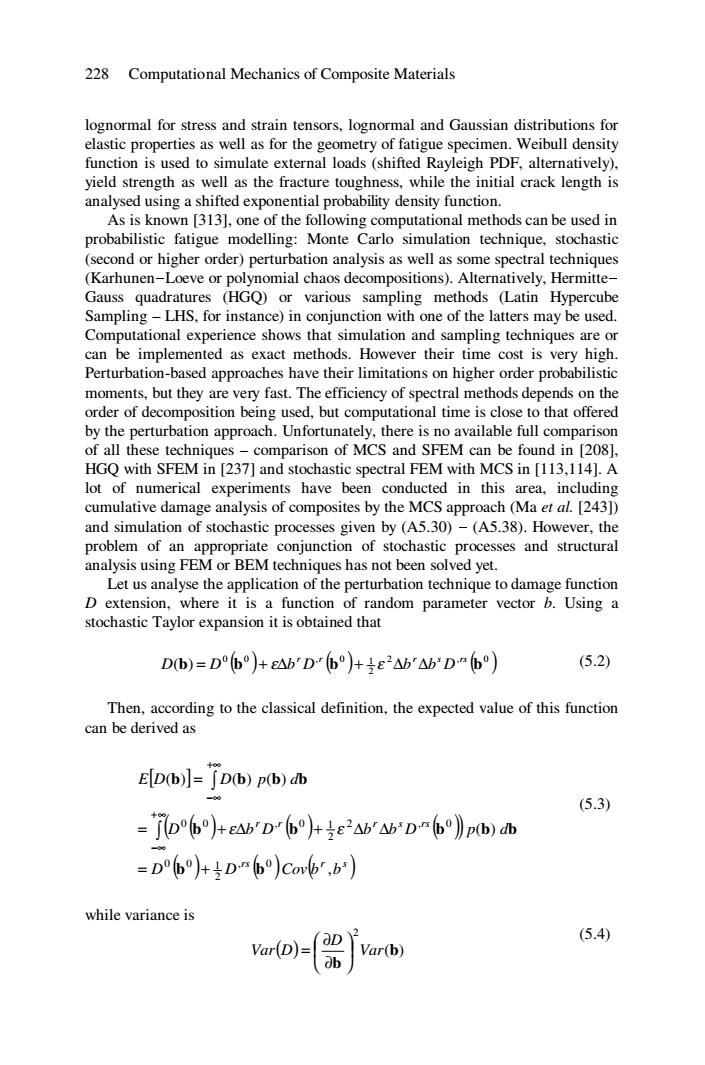正在加载图片...

228 Computational Mechanics of Composite Materials lognormal for stress and strain tensors,lognormal and Gaussian distributions for elastic properties as well as for the geometry of fatigue specimen.Weibull density function is used to simulate external loads(shifted Rayleigh PDF,alternatively), yield strength as well as the fracture toughness,while the initial crack length is analysed using a shifted exponential probability density function. As is known [313],one of the following computational methods can be used in probabilistic fatigue modelling:Monte Carlo simulation technique,stochastic (second or higher order)perturbation analysis as well as some spectral techniques (Karhunen-Loeve or polynomial chaos decompositions).Alternatively,Hermitte- Gauss quadratures (HGQ)or various sampling methods (Latin Hypercube Sampling-LHS,for instance)in conjunction with one of the latters may be used. Computational experience shows that simulation and sampling techniques are or can be implemented as exact methods.However their time cost is very high. Perturbation-based approaches have their limitations on higher order probabilistic moments,but they are very fast.The efficiency of spectral methods depends on the order of decomposition being used,but computational time is close to that offered by the perturbation approach.Unfortunately,there is no available full comparison of all these techniques-comparison of MCS and SFEM can be found in [208]. HGQ with SFEM in [237]and stochastic spectral FEM with MCS in [113,114].A lot of numerical experiments have been conducted in this area,including cumulative damage analysis of composites by the MCS approach (Ma et al.[243]) and simulation of stochastic processes given by (A5.30)-(A5.38).However,the problem of an appropriate conjunction of stochastic processes and structural analysis using FEM or BEM techniques has not been solved yet. Let us analyse the application of the perturbation technique to damage function D extension,where it is a function of random parameter vector b.Using a stochastic Taylor expansion it is obtained that Db)=Db°)+b'Db°)+E2b'bDrb°) (5.2) Then,according to the classical definition,the expected value of this function can be derived as E[D(b)]=jD(b)p(b)db (5.3) =jb6+b'D-6+e2山山D严6》pbd =D6+D严6)cob,b) while variance is va()pVar(b (5.4)228 Computational Mechanics of Composite Materials lognormal for stress and strain tensors, lognormal and Gaussian distributions for elastic properties as well as for the geometry of fatigue specimen. Weibull density function is used to simulate external loads (shifted Rayleigh PDF, alternatively), yield strength as well as the fracture toughness, while the initial crack length is analysed using a shifted exponential probability density function. As is known [313], one of the following computational methods can be used in probabilistic fatigue modelling: Monte Carlo simulation technique, stochastic (second or higher order) perturbation analysis as well as some spectral techniques (Karhunen-Loeve or polynomial chaos decompositions). Alternatively, HermitteGauss quadratures (HGQ) or various sampling methods (Latin Hypercube Sampling – LHS, for instance) in conjunction with one of the latters may be used. Computational experience shows that simulation and sampling techniques are or can be implemented as exact methods. However their time cost is very high. Perturbation-based approaches have their limitations on higher order probabilistic moments, but they are very fast. The efficiency of spectral methods depends on the order of decomposition being used, but computational time is close to that offered by the perturbation approach. Unfortunately, there is no available full comparison of all these techniques – comparison of MCS and SFEM can be found in [208], HGQ with SFEM in [237] and stochastic spectral FEM with MCS in [113,114]. A lot of numerical experiments have been conducted in this area, including cumulative damage analysis of composites by the MCS approach (Ma et al. [243]) and simulation of stochastic processes given by (A5.30) - (A5.38). However, the problem of an appropriate conjunction of stochastic processes and structural analysis using FEM or BEM techniques has not been solved yet. Let us analyse the application of the perturbation technique to damage function D extension, where it is a function of random parameter vector b. Using a stochastic Taylor expansion it is obtained that () () ( ) 2 , 0 2 0 0 , 0 1 (b) b b b r r r s rs D = D + ε∆b D + ε ∆b ∆b D (5.2) Then, according to the classical definition, the expected value of this function can be derived as [ ] ( ) () () ( ) ( ) () ( ) rs r s r r r s rs D D Cov b b D b D b b D p d E D D p d , ( ) ( ) ( ) ( ) , 0 2 0 0 1 2 , 0 2 0 0 , 0 1 b b b b b b b b b b b = + = + ∆ + ∆ ∆ = ∫ ∫ +∞ −∞ +∞ −∞ ε ε (5.3) while variance is ( ) ( ) 2 b b Var D Var D ⎟ ⎠ ⎞ ⎜ ⎝ ⎛ ∂ ∂ = (5.4)